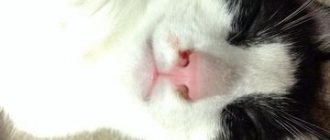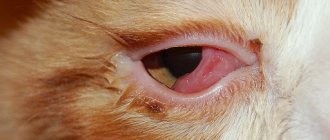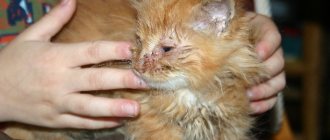For various reasons, your furry pet or cat's eyes are running . We will discuss in more detail what to do and what to do in this article, which will tell you when such a condition is normal, and when you should run to the veterinarian. This could be anything from a simple allergy to scratches that require immediate veterinary attention. A cat's eyes are a complex platform that does not tolerate experimentation.
Reasons for tears
If a cat’s eyes are running, only a veterinarian can tell you what to treat, since the secretion of tear fluid is a defensive reaction in response to irritants, almost all of which are due to illness:
- inflammation of the conjunctiva (this is a symptom of a pathological condition; viral conjunctivitis could be avoided by timely vaccination!);
- against the background of a cold (rinotracheitis);
- the presence of intestinal parasites (therefore it is necessary to repeat deworming every 3 months);
- allergies (to household chemicals, dust, food, animal care products, etc.);
- mechanical damage (trauma, foreign body);
- anatomical predisposition (Persians, etc.);
- infection from outside;
- eye lesions: blepharitis, keratitis, neoplasms, etc.
And this list is not complete yet. As you can see, it’s impossible to figure this out without a veterinary education. And to treat at random...
Reasons why a cat's eyes are watery
Let's consider the first option, when lacrimation is not a disease
Why might there be a problem with the organs of vision if the animal is healthy?
There are several good reasons for this:
- Unsuitable diet for your cat.
- There are breeds, for example, Scottish, in which the structure of the muzzle, in particular the tear duct, is such that it seems that the cat’s eye is constantly leaking.
- The cat slept for a long time, and as a result a similar problem may arise.
- The cat does not have allergies, but some aggressive chemical components, hygiene products, detergents and detergents, medications, etc., can cause an allergic reaction, a sign of which will be discharge from the eyes.
All these cases are common occurrences. But this only indicates temporary discomfort for the murka. The reason will go away, the cat’s eyes will not run. These are tears. And you should not sound the alarm if it turns out that they have some unusual color, for example, slightly cloudy, reddish or grayish.
© shutterstock
At least you need to watch the cat for a while. If the reason that caused the problem goes away, or we neutralize it, and the kitten continues to “cry,” then, most likely, the pathogen is something else and the problem is much deeper.
Moreover, tears themselves do not look attractive. And even if the problem itself is only aesthetic, it needs to be solved. There are suitable and inexpensive methods and affordable means for this that can be found in every home.
Let's consider the second option, when if there are reasons why the cat's eyes may be watery, and she is actually sick. Which?
Here are the most common and widespread:
- Even a domestic cat can get parasites. And the eyes that flow show it.
- Any type and complexity of injury. The cat got into a fight and the enemy cut his eye, or our tomboy fell off the cabinet and hurt his head. These and other injuries can form the basis of a very complex process, which will lead to the fact that the eye begins to fester.
- Infectious inflammation of the conjunctiva is something that many of our pets encounter due to their free lifestyle or our inept handling of them.
- Bacteria and fungi. It is difficult to completely neutralize this reason. But it is possible to quickly cure the eyes of cats if you start the right treatment.
- Allergy. Did you know that our four-legged friends are very sensitive and all the products we use to clean our home are very harmful to them? But that’s not all; often, in pursuit of savings, we can harm our pet if we choose low-quality cat care products.
- Intolerance to certain medications also leads to the kitty developing a reaction where the eyes run.
- Blepharitis is inflammation of the eye. This disease can occur due to any type of injury: eyelid bruise, chemical burn, cut or tear. But it doesn't stop there. Further, the wound becomes infected due to the fact that viruses and microbes can freely enter the eye. The eye swells and begins to fester.
The reasons are all serious enough for you to start treating your cat without delay. After all, the point is not only in the appearance of the fluffy, but also in the fact that he feels great discomfort, his eye itches and itches. And when he starts scratching it, he makes the problem even worse. The wound does not shrink, but increases, which means the area of access to microbes and viral infections increases. And his paws are not that clean, which is how he spreads the infection.
Our decision to cure the cat has matured, and we want to do it quickly and without special expenses. This is why many decide to treat at home, armed with old antiquated remedies and Wikipedia, which should know everything . But there is a huge and significant minus in all this. Which? Think about it! Do you know exactly what caused your pet’s illness? We found out that there may be several reasons. But why exactly are your furry furry's eyes running?
© shutterstock
Even if it seems to you that you know exactly the answer to this question, then do not rush, for fear of harming your pet. It's best to be sure. To do this, you should consult a doctor.
Symptoms of lacrimation
Depending on the type and severity of the disease, they look different:
- slightly swollen eyes with slight discharge;
- lacrimation for too long;
- the liquid tear secretion changes to a thicker one;
- a dried brown mass gradually forms on the inner corners of the eyes;
- itching occurs due to illness and fluid leakage due to rubbing the eyes;
- severe swelling and redness of the conjunctiva;
- in conditions where the temperature rises, a depressed state and photophobia occur.
Dirt in a cat's eye
Watery eyes can be caused by a clogged eye. Since a cat is a very clean creature, constantly licking its fur after eating, it is quite possible that a piece of hair or a speck of dust has gotten under the eyelid. In this case, only one eye will water. Watch your pet. If he is worried and rubs his muzzle with his paws, then perhaps a microscopic foreign body has actually gotten into his eye. Then you should wait a little while the debris is washed away with a tear.
If the cat remains restless for quite a long time, 3-4 hours, then you can help the pet by dropping an artificial tear into the eye. Drinking plenty of fluid will help flush out any remaining debris from the diseased organ.
First aid at home
If your pet does not show any signs of anxiety, then at first you can limit yourself to eye hygiene (and, for prevention, you need to teach your cat to do it regularly and from a young age!), washing twice a day with herbal products (a decoction of chamomile petals prepared in steam bath), a light solution of potassium permanganate or at least saline solution.
If pus appears in the discharge, then decoctions of sage, calendula, St. John's wort, an infusion (not freshly brewed) of black tea, and a special zoo lotion can help. Try compresses to the eyes several times a day.
It is recommended to give phytomins and phytomineral eye food.
If the condition continues to worsen, for example, the cat has lost his appetite, is sneezing, and the temperature is above 39, then it may be a viral infection. An accurate diagnosis will be made in a veterinary clinic using an analysis of the conjunctival sac washout, and then the appropriate treatment will be selected.
Symptoms to watch out for
When an owner notices that his pet's eyes are watering, he must understand the possible reasons. This is probably a common occurrence for a cat and does not threaten its health, or, conversely, a sign that it is time to see a doctor.
Healthy cat eyes are always clean
If the owner of a fluffy beauty is sure that this is not a common occurrence, then he should pay attention to the following symptoms:
- lack of appetite in the pet;
- noticeable injuries to the eye;
- increased body temperature;
- weakness, unsociability;
- diarrhea;
- color of discharge (transparent with a gray or red tint, purulent);
- It is difficult for a cat to open its eyes, especially in bright light.
Important! When the owner is convinced that the cat does not have the above symptoms, and the discharge looks like a tear, then there is no reason to worry. Again, if the phenomenon was short-lived. If an animal “cries” for a long time, then this is a reason to visit a veterinary clinic.
You should examine your cat's eyes very carefully:
- It is necessary to wash your hands before examination;
- Gently pull back the upper eyelids on the teary eye or both.
When the eyelids become red or swollen and the cornea becomes cloudy, this is a sign of eye inflammation. But if the eyes are not cloudy, the cornea is clear, the pupils are the same size, and the back of the eyelids are pale pink, then there are most likely no serious problems.
What do we treat?
And if it is impossible to visit a veterinarian in the near future, what should you do?
To alleviate the condition of a sick pet, you will have to help him at home with something at your discretion:
- instill Furacilin 0.2%, Tsiprovet, Levomycetin, Sofradex or Kanamycin 2-3 drops in both eyes 5 times a day;
- apply antibiotic-based ointments 2-3 times a day;
- in case of severe swelling, when the pain intensifies, use a solution of hydrocortisol and novocaine;
- in case of entry of a foreign body; if you can, remove it: it is advisable to first give an anesthetic injection (with a children's insulin syringe, preferably from Poland), then use tweezers and a cotton swab with saline solution, turn the eyelid outward and pull out the particle;
- in case of allergies, it is necessary to identify the irritant and protect the pet from it (and treatment is prescribed by a veterinarian with hormonal drugs).
The cat's eyes are running: what to do if you cannot visit the doctors yourself
Especially for such a case when a cat’s eyes are running, but it is not possible to visit a veterinarian on your own. If you are not indifferent to the health of your four-legged friend, we offer a home visit service for a veterinarian. It will be appreciated by every modern person who sits late at work and does not fit into the schedule of the veterinary center. In such cases, we have our emergency veterinary care for animals. We are ready to come around the clock and do what is required for a speedy recovery of your pet.
What to do if there is discharge from the eyes
First you need to take your pet to the vet. After examination and necessary tests, the doctor will make a diagnosis and determine treatment. If there is an infection, then antiviral and antibacterial drugs. Drops and ointments are also prescribed to relieve inflammation.
Other treatment options:
- if it is a foreign body, neoplasm – removal;
- in case of an allergic reaction - antihistamines;
- if necessary, physiotherapeutic treatment;
- problem with the kidneys, liver, gastrointestinal tract - targeted therapy.
Before visiting a veterinarian, it is allowed to alleviate the pet’s condition. You need to rinse your eyelids with light and gentle movements using a cotton pad. You can moisten with antiseptics without alcohol, saline. solution, infusion of chamomile or oak bark. It is impossible to start lacrimation with purulent discharge, as the risk of losing vision increases.
Viral or bacterial eye infection
A cat's eyes may become watery due to a viral or bacterial infection. If your pet's discharge has been going on for quite some time, and it has become thick, cloudy white or yellow, then most likely there is an infection in the eyes that is rapidly gaining momentum.
This could be conjunctivitis, toxoplasmosis, or herpetic infection. It is necessary to undergo an examination by a veterinarian in Murmansk. Ignoring these alarming symptoms can significantly weaken your cat's vision and even lead to blindness. The specialist will prescribe a series of tests to identify a hidden infection in the body and draw up a treatment plan for your pet.
Treatment options
After making a diagnosis, the ophthalmologist decides what to do and how to treat the cat. In the simplest scenarios for the development of epiphora, this can be done regardless of other diseases:
- if foreign objects are detected, they are removed - therapy involves the use of eye drops and ointments;
- getting rid of curled eyelashes in a cat is done using electrolysis or cryosurgery (low-temperature effects on the area);
- Lacrimal punctal stenosis is corrected surgically.
Most often, a one-time intervention is enough to completely rid the cat of the disease. Relapses are extremely rare and repeat procedures are almost never required.
Important! If epiphora in a cat has developed due to an infectious disease, the veterinarian will first prescribe treatment for the underlying disease, and only then eliminate the residual effects of lacrimation.










